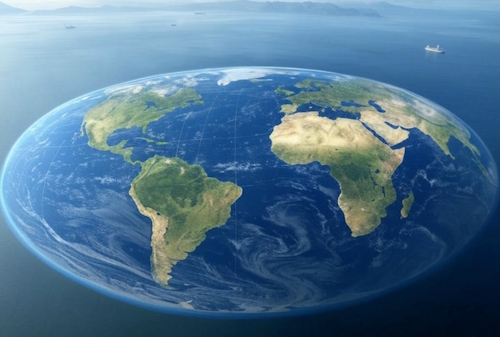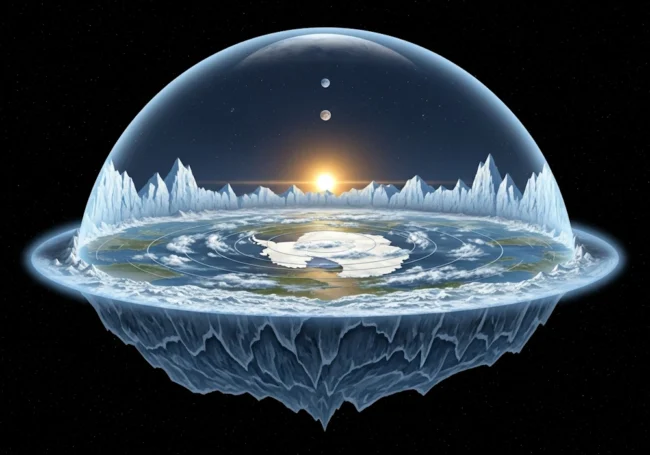The flat Earth movement represents one of the most notable examples of modern scientific denialism. Despite overwhelming scientific evidence that our planet is roughly spherical, a small but vocal community continues to believe and advocate that Earth is actually flat.
Origins and Psychology
Belief in a flat Earth persists for several psychological and sociological reasons:
- Distrust of authority: Many flat Earth believers harbor deep skepticism toward scientific institutions, governments, and educational systems, believing these entities deliberately mislead the public.
- Simplicity and sensory experience: The flat Earth concept aligns with immediate sensory perception—the ground appears flat to casual observation, and people don’t “feel” the Earth’s rotation.
- Community and identity: The flat Earth community provides a sense of belonging and special knowledge, with members viewing themselves as “truth-seekers” who have discovered hidden realities.
- Internet echo chambers: Online platforms allow like-minded individuals to reinforce each other’s beliefs while filtering out contradictory information.
Core Flat Earth Beliefs

While there are variations among flat Earth models, common elements include:
- Disc-shaped Earth: Most flat Earth proponents describe Earth as a circular disc with the Arctic Circle at the center and Antarctica as an ice wall extending around the circumference.
- Enclosed system: Many believe a dome or “firmament” covers the flat Earth, containing the sun, moon, and stars.
- NASA conspiracy: A fundamental tenet holds that space agencies worldwide, particularly NASA, fabricate evidence of a spherical Earth and space travel.
- Gravity rejection: Many flat Earth believers dispute conventional gravitational theory, instead suggesting Earth accelerates upward or that density and buoyancy alone explain why objects fall.
How Flat Earth Believers Explain Natural Phenomena
Flat Earth proponents have developed alternative explanations for observations that conventional science attributes to Earth’s spherical nature:
- Day and night cycles: The sun is portrayed as a spotlight-like object that moves in circles above the flat Earth, illuminating different regions to create day and night.
- Seasons: Adherents explain seasons as resulting from the sun’s circular path expanding and contracting, moving closer to or further from the Arctic center.
- Eclipses: Some suggest the moon’s shadow causes solar eclipses, while lunar eclipses might be attributed to an unseen “shadow object.”
- Ships disappearing hull-first: This phenomenon is often explained as resulting from perspective limitations or atmospheric conditions rather than Earth’s curvature.
- Time zones: Different time zones exist because the spotlight-like sun illuminates different parts of the flat Earth at different times.
Evidence That Addresses Flat Earth Claims
Several observable facts and experiments directly challenge flat Earth theories:
- Ship hull disappearance: Ships disappear from bottom to top when sailing away—precisely what would be expected on a curved surface but not on a flat one.
- Coriolis effect: The consistent pattern of rotation in hurricanes (counterclockwise in the Northern Hemisphere, clockwise in the Southern) can only be explained by Earth’s rotation.
- Star patterns: Different stars are visible from different hemispheres. If Earth were flat, everyone would see the same stars.
- Varying shadow lengths: At the same time on the same day, shadows in different locations have different lengths due to Earth’s curvature.
- Direct observation: High-altitude photographs and videos—even those taken by private individuals with weather balloons—show Earth’s curvature.
- Circumnavigation: People have repeatedly circumnavigated the globe in all directions, which would be impossible on most flat Earth models.
- Satellite technology: GPS and telecommunications systems rely on satellites orbiting a spherical Earth—their practical functionality provides daily proof of Earth’s shape.
- Lunar eclipses: The curved shadow of Earth on the moon during lunar eclipses has been observed for thousands of years.
The Simulation Hypothesis: A Flat Earth in a Holographic Reality

Some flat Earth theorists propose an even more radical alternative: that we live in a holographic simulation or programmed reality where conventional physics doesn’t apply. This perspective suggests:
Core Simulation Theory Concepts
- Illusory cosmos: The sky, stars, sun, and moon are merely projections or programmed elements designed to create the illusion of space and celestial bodies.
- Programmed physics: What we perceive as gravity, motion, and natural laws are simply programmed rules of the simulation that maintain consistent experiences.
- Limited boundaries: The Earth is flat with defined edges or boundaries beyond which the simulation prevents exploration, possibly explaining why Antarctica is difficult to access independently.
- Perceptual manipulation: Our senses are being constantly manipulated to perceive a spherical Earth and vast cosmos when neither exists in this framework.
Implications of a Simulated Flat Earth Reality
If this hypothesis were true, numerous profound implications would follow:
- Controlled perception: All scientific instruments and observations would be providing manipulated data designed to maintain the illusion of a spherical Earth in space.
- Universal deception: Every astronaut, pilot, satellite engineer, and space agency employee would either be participating in the deception or also be deceived.
- Perfect consistency: The simulation would need to maintain perfect consistency across billions of observers through countless scenarios, creating coherent experiences for everyone.
- Orchestrated communication: All telecommunications, including satellites, would be operating through hidden mechanisms rather than the orbital systems we perceive.
- Reality programming: Weather patterns, seasons, day/night cycles, and celestial events would all be programmed sequences rather than natural phenomena.
Scientific Evaluation of the Simulation Hypothesis
While philosophically interesting, this hypothesis faces several critical challenges:
- Unfalsifiability: By definition, a perfect simulation would be indistinguishable from reality, making the hypothesis scientifically unfalsifiable.
- Occam’s Razor: This principle suggests that explanations requiring the fewest assumptions are most likely correct. A simulated reality requires vastly more complex assumptions than a spherical Earth.
- Internal consistency: Our understanding of physics has developed through observation and experimentation, with each discovery building on previous knowledge. The remarkable consistency of these findings across different domains suggests an underlying reality rather than programmed illusions.
- Purpose question: The simulation hypothesis raises the question of why such an elaborate deception would be maintained and by whom, without providing testable answers.
- Computational requirements: The processing power required to simulate quantum physics, human consciousness, and all observable phenomena down to the subatomic level would be astronomical, raising questions about the feasibility of such a simulation.
Physical Consequences of a Hypothetical Flat Earth
If Earth were actually flat, the physical implications would be profound and immediately noticeable in our daily lives. Here’s what might happen in such a hypothetical scenario:
Gravitational Anomalies
- Inconsistent gravitational pull: On a flat disc, gravity would pull toward the center of mass, meaning objects would experience a sideways gravitational pull that increases with distance from the center. The further from the center, the more objects would tilt toward it.
- Edge effects: Near the supposed edge (the Antarctic “ice wall” in most flat Earth models), objects would experience severe gravitational distortion, with everything tilting noticeably toward the center of the disc.
- Building challenges: Construction of tall structures would be impossible away from the center, as buildings would need to account for the non-perpendicular gravitational pull.
- Flight paths: Aircraft would need to constantly adjust their altitude to account for the changing gravitational vector across distances, making long-distance flight routes completely different from what we experience.
- Maritime navigation: Ships would drift toward the center of the disc unless constantly corrected, making east-west travel routes exponentially longer than north-south routes.
Atmospheric and Climate Disruption
- Wind patterns: Without a rotating sphere, global wind patterns like the trade winds and jet streams could not exist as we know them.
- Uneven heating: The “spotlight sun” model would create severe temperature gradients incompatible with observed climate patterns. Areas at similar distances from the Arctic center would have wildly inconsistent seasons.
- Atmosphere distribution: Air would concentrate toward the center of the disc due to gravitational effects, making the atmosphere thinner at the edges and potentially uninhabitable.
Conclusion
While flat Earth beliefs persist among a small segment of the population, they do so against overwhelming scientific evidence. The simulation hypothesis represents an even more extreme position that, while philosophically intriguing, lacks scientific testability and requires extraordinary assumptions.
The persistence of flat Earth theories in the modern information age demonstrates the powerful role that trust, community, and personal identity play in shaping what people are willing to accept as true, even when faced with substantial contradictory evidence.
The scientific method—with its emphasis on observation, experimentation, and peer review—remains our most reliable tool for understanding reality, whether that reality is fundamental or, as some might speculate, programmed.

Leave a Reply